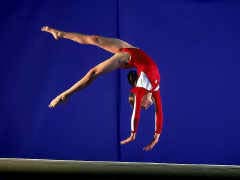|
Playing Like a Girl
Part
3: The Invisible Problem

Allsport Photography,
inc. |
According
to a 1999 study conducted by the NCAA, there are two sources
of pressure to be thin in athletics: performance and appearance.
The study
states that "performance thinness refers to the commonly held
belief that achieving a lower weight and lower percentage
body fat will enhance performance for all athletes, particularly
in the endurance sports," such as track and basketball. Appearance
thinness, on the other hand, "refers to the trend over the
last several decades to reward thinner athletics in the adjudicated
sports such as gymnastics and figure skating."
| "In
a way, [my eating disorder] was just one more thing to
become a better athlete -- work out more hours, stretch
longer... eat less, purge more." |
The pressure
to conform to these norms, Sachs says, comes from coaches,
friends and society in general, often leading to unhealthy
eating habits.
Brittany
Paloma, a 16-year-old high school student, talks about how
hard it is for cheerleaders to be overweight. "You can hear
the crowd murmur as the people around you start saying 'Where's
the fat one? Where's the fat one?' and they start to point
her out. Then you can hear laughs and giggles and 'My god,
look at her jiggle!' and 'Wow, doesn't she hate herself?'
and 'I can't believe they let a fat girl on the squad!' She's
a great cheerleader, very flexible, wonderful jumps, and even
does a little tumbling, but she will always be known as 'The
Fat One.'
Girls
see that happening and they think to themselves, 'I'm not
going to do it, I don't want to be 'The Fat One.''' "Heck,"
she says, "I've thought it myself even though I'm not fat."
Even when
being overweight is not the issue, "wrong" body type can trigger
disordered eating. "I was never fat," says the rugby player
who had trained to be a dancer from the age of four to the
age of 13. That was when she was told her height to weight
proportions were unsuitable for dance competition.
"I'd been
with the same company and studio for eight years, most of
my life, and to be told by the people, who had for so long
been my idols, that I couldn't dance… I'm sure I was devastated,"
she says. She quit dancing and, as a result, became anorexic
in an attempt to change her body and prove that she could
be a dancer, even though her desire to dance was gone.
Even now
that she plays rugby, a sport where bigger is often an asset,
the eating disorder remains. The thin ideal always lurks in
the back of her mind. "In order to maintain the image that
I'm a healthy person," she says, "I feel I should look the
part."
She, like
other female athletes with eating disorders, finds it difficult
to recognize that she has a problem at all and that her eating
behavior is not normal. "Right now I'm at a stage where I
constantly have to remind myself, 'No, throwing up is not
normal… Yes, you are very sick… No, eating a banana is not
going to make you fat.' My head doesn't always remember that
I am sick. I guess sometimes it tells me that I'm just a liar
and that none of what's going on is real."
Meg R.,
a 28-year-old marathon runner who suffers from bulimia, often
gets mixed messages from others about her body. She finds
that it is easy for people to confuse unhealthy thinness for
athleticism. While friends, family members, other runners
and coworkers often comment that she looks anorexic, others
tell her, "'You look like a runner.'" Naturally, this would
be confusing for anyone, but for someone with an eating disorder,
it is especially difficult to separate the two.
According
to Borysowicz, the sports world is an environment in which
athletes can easily hide their eating disorders.
Cara S.,
the former dancer and competitive gymnast, now 30 years old,
explains that, "my entire identity was wrapped up in being
a ballerina, or in being a gymnast, as opposed to being a
person who danced, or a person who did gymnastics." And if
being a dancer or gymnast meant having a specific kind of
body, Cara was determined to have that body.
"In a
way, [my eating disorder] was just one more thing to become
a better athlete -- work out more hours, stretch longer, do
more repetitions, eat less, purge more," she says. "If you
were to ask [my fellow dancers and gymnasts] if my eating
behavior was abnormal, they would have said no without any
hesitation. And they would have meant it too."
NEXT:
Starving For Control >>
|

